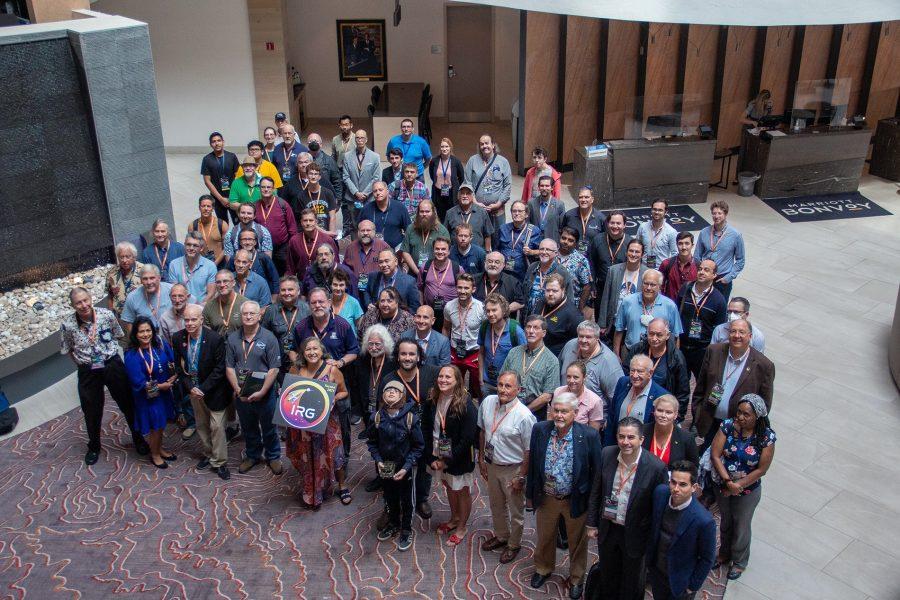The seventh annual national Interstellar Symposium was presented by the Interstellar Research Group and hosted by the University of Arizona at the Marriott University Park from Friday, Sept. 24 to Monday, Sept. 27.
This event featured numerous presentations with a range of out of this world topics, from black hole bomb beams to the effects that space has on physiological processes in the body to the process of creating dynamic propulsion methods for rockets.
Each day’s agenda was broken into plenary sessions, which were done by keynote speakers and other participants, with breaks and tours of places like Biosphere 2, the Tree Ring Research Lab and the Richard F Caris Mirror Lab.
The plenary sessions gave audience members a chance to hear about qualified professionals’ work and ask questions. IRG plans these symposiums and invites the speakers with the goal to inspire and bring about further conversations regarding space and where its future might take us.
RELATED: UA researches using swarms of robots to mine on moon’s surface
There were over 50 speakers at the event, with some more familiar to the university than others. Kai Staats, the Director of the Space Analog for the moon and Mars at Biosphere 2, is an example of one who was very close to home.
Staats gave multiple speeches at the Symposium. His first seminar was titled “The Challenge of Closed-loop and Bioregenerative Life Support for Long Duration Space Exploration,” In this talk Staats and other professionals commented on the hardships they encountered during the project.
On Monday, Staats went into detail about his work in the session “SAM: Construction of a Hi-fidelity, Hermetically Sealed Mars Habitat Analog at Biosphere 2.” His descriptions of the lung at Biosphere 2, which is a 3,000 pound dish of concrete and steel completely suspended by air, as well as the group’s experimentation with pressure suits to stay completely isolated from the outer world, showed how Biosphere 2 hopes to prepare us for living outside of Earth.
“Biosphere 2 represents what we might do on a planet 150 to 200 years from now,” Staats said in response to one of the audience member’s questions.
RELATED: Researchers seek participants for jet lag study with $500 compensation
Also on Monday, Dr. Mark Shelhamer, who has worked with NASA to study sensorimotor adaptation to space flight and serves as an advisor to those interested in commercial spaceflight, gave the talk, “Challenges to Crew & Mission Health & Performance in Ventures Beyond Near Earth.”
Shelhamer spoke on the physical and mental challenges that come with taking people into space, such as the effects of isolation on the mind and the increased chances of developing kidney stones due to one’s bones and muscles being broken down in zero gravity.
“There still have been fewer than 600 people who have gone into space [and] everyone one of those is an experiment,” Shelhamer said to explain how difficult it can be to account for every mishap that can happen on a mission.
Further making Shelhamer’s quest to research the effects of space on people challenging, is the many layers of protection that are put in place to protect all astronauts’ personal information, like HIPAA, which make it so any discoveries made on a space flight about specific individuals cannot be published. On a lighter note, however, Shelhamer has high hopes that the next generation may find ways to answer the questions he has been asking.
“At my age, you have to force yourself to think, ‘This is really cool’, but [in college] you’re not at that been-there-done-that stage,” Shelhamer said.
Another speaker, Troy Howe focuses his research on how to get into space. Howe is the president of Howe Industries, which he started in 2015 when he was 32 years old and has a PhD in Mechanical Engineering from the University of Idaho. His team has received grants and been contracted by NASA to figure out just what power source can push a rocket all the way to Mars.
While chemical rockets are good for short term missions, Howe states that nuclear thermal or nuclear plasma propulsion are better alternatives for longer missions. Testing this though, poses a challenge. One must isolate the single thing they are trying to test that day and then expose it to the conditions it is going to have to withstand.
Howe believes the work being done in space applies to the needs we see back on Earth. For example, Howe and his team’s work on power generation may prove to be 5% more efficient than what is used now.
Plans for IRG’s eighth Interstellar Symposium are already underway thanks to their partnership with Andrew Higgins, a mechanical engineering professor at McGill University who gave the talk “Dynamic Soaring as a Means to Exceed the Solar Wind Speed” at the Symposium.
Sometime in June of 2023, the eighth Symposium will be held in Montreal, Quebec, Canada and hosted by McGill University. According to Higgins, this decision was made so that IRG could reach an audience outside of the United States.
“Before we go interstellar, we must go international,” Higgins said in his closing statement on Monday.
Follow Trinity Clark on Twitter









